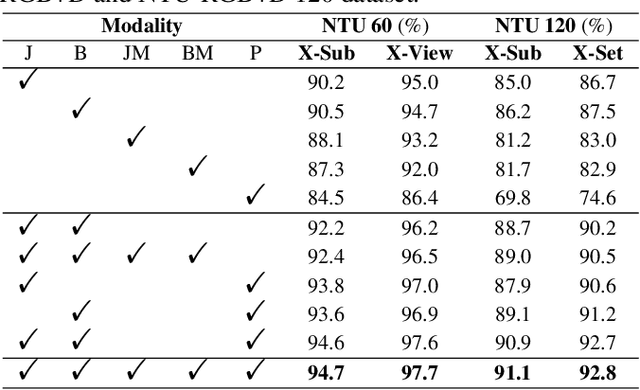Nan Dai
Explore Human Parsing Modality for Action Recognition
Jan 04, 2024

Abstract:Multimodal-based action recognition methods have achieved high success using pose and RGB modality. However, skeletons sequences lack appearance depiction and RGB images suffer irrelevant noise due to modality limitations. To address this, we introduce human parsing feature map as a novel modality, since it can selectively retain effective semantic features of the body parts, while filtering out most irrelevant noise. We propose a new dual-branch framework called Ensemble Human Parsing and Pose Network (EPP-Net), which is the first to leverage both skeletons and human parsing modalities for action recognition. The first human pose branch feeds robust skeletons in graph convolutional network to model pose features, while the second human parsing branch also leverages depictive parsing feature maps to model parsing festures via convolutional backbones. The two high-level features will be effectively combined through a late fusion strategy for better action recognition. Extensive experiments on NTU RGB+D and NTU RGB+D 120 benchmarks consistently verify the effectiveness of our proposed EPP-Net, which outperforms the existing action recognition methods. Our code is available at: https://github.com/liujf69/EPP-Net-Action.
Integrating Human Parsing and Pose Network for Human Action Recognition
Jul 16, 2023



Abstract:Human skeletons and RGB sequences are both widely-adopted input modalities for human action recognition. However, skeletons lack appearance features and color data suffer large amount of irrelevant depiction. To address this, we introduce human parsing feature map as a novel modality, since it can selectively retain spatiotemporal features of the body parts, while filtering out noises regarding outfits, backgrounds, etc. We propose an Integrating Human Parsing and Pose Network (IPP-Net) for action recognition, which is the first to leverage both skeletons and human parsing feature maps in dual-branch approach. The human pose branch feeds compact skeletal representations of different modalities in graph convolutional network to model pose features. In human parsing branch, multi-frame body-part parsing features are extracted with human detector and parser, which is later learnt using a convolutional backbone. A late ensemble of two branches is adopted to get final predictions, considering both robust keypoints and rich semantic body-part features. Extensive experiments on NTU RGB+D and NTU RGB+D 120 benchmarks consistently verify the effectiveness of the proposed IPP-Net, which outperforms the existing action recognition methods. Our code is publicly available at https://github.com/liujf69/IPP-Net-Parsing .
 Add to Chrome
Add to Chrome Add to Firefox
Add to Firefox Add to Edge
Add to Edge